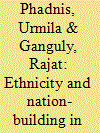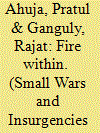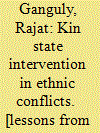|
|
|
Sort Order |
|
|
|
Items / Page
|
|
|
|
|
|
|
| Srl | Item |
| 1 |
ID:
052272


|
|
|
|
|
| Publication |
New Delhi, Sage Publications, 2003.
|
| Description |
292p.
|
| Standard Number |
0761996044
|
|
|
|
|
|
|
|
|
|
|
|
Copies: C:1/I:0,R:0,Q:0
Circulation
| Accession# | Call# | Current Location | Status | Policy | Location |
| 046779 | 305.800954/GAN 046779 | Main | On Shelf | General | |
|
|
|
|
| 2 |
ID:
049326


|
|
|
|
|
| Edition |
Rev. ed
|
| Publication |
New Delhi, Sage Publications, 2001.
|
| Description |
467p.
|
| Standard Number |
8170369797
|
|
|
|
|
|
|
|
|
|
|
|
Copies: C:1/I:0,R:0,Q:0
Circulation
| Accession# | Call# | Current Location | Status | Policy | Location |
| 043885 | 305.800954/PHA 043885 | Main | On Shelf | General | |
|
|
|
|
| 3 |
ID:
080092


|
|
|
|
|
| Publication |
2007.
|
| Summary/Abstract |
India is at a crossroads today. While it is fast emerging as a global power with a vibrant democratic polity, a robust economy and a nuclear-weapons capable military, the country is also witnessing a growing polarisation between the rich and poor and between urban and rural areas, a rise in communal tensions, large numbers of suicides by impoverished and indebted farmers and a spurt in terrorist activities and attacks by various disgruntled organisations and groups. Of these various challenges, as attested to by Prime Minister Manmohan Singh himself, the most dangerous threat to India's territorial integrity, prosperity and wellbeing has come from the Naxalite insurgency or 'people's war' that is manifest in large areas of eastern, central and southern India. But what factors account for the formation and persistence of Naxalite insurgency in India? What are the key objectives of the Naxalites and why is violence directed against the Indian State? And how has the Indian State (both central and state governments) responded to the Naxalite insurgency and with what effect? These are the main research questions that we attempt to answer in this paper. We put forward two broad arguments. First, the Naxalite insurgency in India is the latest manifestation of peasant struggles caused by grinding poverty, exploitation and inequality that have prevailed in rural areas for centuries. What sustains these struggles to this day is the fact that socio-economic conditions in rural areas have changed little and the policies followed by the post-independent Indian State have generally failed to mitigate rural problems. Second, the Naxalite insurgency has emerged as the most dangerous threat mainly due to the movement's spatial spread, growing support base in tribal and backward areas and enhanced fighting capabilities. The Indian State has viewed the movement as a 'law and order' problem and responded with force. But a 'law and order' approach to the Naxalite insurgency is unlikely to produce a lasting resolution of the problem, since it would not effectively redress deep-rooted grievances felt by a majority of India's rural poor for decades.
|
|
|
|
|
|
|
|
|
|
|
|
|
|
|
|
| 4 |
ID:
140384


|
|
|
|
|
| Summary/Abstract |
The Indian military is the world’s fourth largest after the US, Russia and China. In the immediate aftermath of India’s independence from British rule, however, it was hard to imagine that in the span of six decades, a poverty-stricken, fragmented and deeply traumatised country would emerge as a military powerhouse. How and why has this transformation taken place? Has India’s growing military prowess resulted in a more robust and adventurist foreign policy, particularly within the South Asian region? What does India’s rapid military transformation, particularly the Indian Navy, in the twenty-first century say about India’s perception of threats to national security? In this article, I argue that the Indian military’s expansion and modernisation has happened in phases, mainly as a reaction to threatening developments within the surrounding region, the evolving global strategic environment and the perceptions and decisions taken by India’s political elites. I argue, further, that as India’s military prowess and self-confidence have grown, Indian leaders have at times felt tempted to flex the military muscles, particularly in low-intensity regional conflicts, but not always with expected results. I conclude that in the twenty-first century, the Indian military, particularly the Indian Navy, is undergoing rapid expansion and transformation. This suggests that in addition to threats coming across the western and northern land borders with Pakistan and China respectively, India’s security planners envisage a growing threat to national security emanating from the deep waters of the Bay of Bengal, the Arabian Sea and the Indian Ocean.
|
|
|
|
|
|
|
|
|
|
|
|
|
|
|
|
| 5 |
ID:
047928


|
|
|
|
|
| Publication |
New Delhi, Sage Publications, 1998.
|
| Description |
266p.
|
| Standard Number |
8170367301
|
|
|
|
|
|
|
|
|
|
|
|
Copies: C:1/I:0,R:0,Q:0
Circulation
| Accession# | Call# | Current Location | Status | Policy | Location |
| 043944 | 305.800954/GAN 043944 | Main | On Shelf | General | |
|
|
|
|
| 6 |
ID:
136662


|
|
|
|
|
| Summary/Abstract |
After nearly 30 years in power, the Hosni Mubarak regime in Egypt, considered by many to be the strongest in the Arab world, collapsed suddenly in February 2011 after a mere 18 days of street protests. In this article, we try to explain the puzzling collapse of the Mubarak regime using regime transition theory. We argue that the Mubarak regime’s collapse came about as a result of four key developments, none of which were sufficient to cause the regime’s collapse, but when coalesced together exposed the regime’s lack of coercive and persuasive powers, thereby hastening its demise. We conclude that regime transition theory, developed to explain the third wave of democratisations in the 1970s and 1980s, is still relevant in explaining transitions from authoritarian rule.
|
|
|
|
|
|
|
|
|
|
|
|
|
|
|
|
| 7 |
ID:
067115


|
|
|
|
|
|
|
|